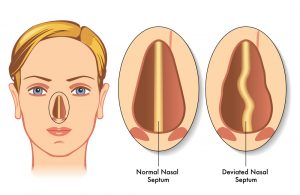All you want to do is take a deep breath, but it’s really hard to because one side of your nose isn’t able to take in enough air. For as long as you can remember, you’ve always had issues with one side of your nose. It seems like you’re always dealing with nasal congestion and many people have even asked if you’re sick. Unfortunately, you’re not suffering from a cold that will go away. You have a deviated septum that doesn’t go away as easily as a virus.
Frequently Asked Questions
We receive many questions pertaining to our deviated septum rhinoplasty procedure. Review the questions and answers below, and if you have any other questions, feel free to reach out to us by calling our office in Burbank at (818) 206-2539.
What Is a Deviated Septum? Does It Cause a Septal Spur?

In some cases, the nasal passage can deviate so much that it blocks one side of the nose. This reduces or blocks airflow making it difficult to breathe. The other issue is the side that is larger has more exposure to the air, which causes it to become dry. This can lead to cracks and bleeding.
A septal spur is a common occurrence for people with a deviated septum. This is a headache that comes from pressure from swelling inside of the nose. Most sufferers are able to find relief by applying a topical anesthetic where the pressure is felt the most.
Nasal congestion or nasal blockage are consequences of a deviated septum. Most people who suffer from this condition take medication to reduce the swelling of the tissues inside the nose. This can help open up the small side of the nasal cavity. Unfortunately, this is the only way to manage the effects of a deviated septum unless you have the septum repaired with surgery.
How Does Someone Get a Deviated Septum?
People are either born with a deviated septum or they suffer from an injury that causes it. Some people will suffer an injury during childbirth and think they were just born with it. If people have someone in their family that has a deviated septum, there’s a better chance it was inherited versus from an injury during childbirth.
Injuries to the nose that can lead to a deviated septum are often traumatic blows to the face. This is common in contact sports, such as football and wrestling. Car accidents are another reason people end up with a deviated septum.
Age-related changes in the nose can lead to a deviated septum or the worsening of the deviation. Some people may not have noticed any issues early in life but as it worsened with age, they started exhibiting symptoms.
How Can Rhinoplasty Help with a Deviated Septum?
A septoplasty must be performed to correct a deviated septum. This procedure takes up to 90 minutes. During the procedure, the surgeon will reposition, trim, and straighten the cartilage and bone that make up the septum.
Many people who have a septoplasty request a rhinoplasty in conjunction with it or vice versa. Since the patient is already under anesthesia and the surgeon is performing work on the nose, it makes sense to work on the inner and outer makeup of the nose to enhance its appearance.
What many people are not aware of is that there is a term for having a septoplasty and rhinoplasty – septorhinoplasty. This is what you can request when interested in having both procedures performed at the same time.
How Does a Deviated Septum Cause Fatigue or Bruising Under the Eyes?
Due to the effects of having a deviated septum, such as nasal congestion, many people do not sleep well at night. They often wake up to blow their nose or even take a breath because they can’t take in enough air through their nose. This can cause daytime fatigue and undereye circles that can seem like bruising under the eyes.
Does a Deviated Septum Cause Poor Sleep or Sleep Apnea in the Future?

Even without suffering from the inability to breathe, people with a deviated septum may sleep poorly because they can’t stay asleep due to the congestion. It’s like sleeping with a cold that never goes away.
Does a Deviated Septum Cause Anxiety?
A deviated septum doesn’t directly cause anxiety. Since it’s difficult to sleep at night and dealing with recurrent sinus infection and congestions can be frustrating, many people have anxiety from it. Anxiety is essentially a byproduct of the symptoms people experience who have deviated septums.
What Health Problems Are Associated with Having a Deviated Septum?
Recurring sinus infections or sinusitis is the most common health problem. This is when the sinuses inflame because of excess mucus in the sinus cavity. Symptoms of sinusitis include:
- Discolored Mucus
- Post-Nasal Drip
- Headaches
- Earaches
- Facial Pain
People who suffer from the above symptoms for over 12 weeks have chronic sinusitis.
Health problems can also result indirectly from having a deviated septum. For instance, those who have sleep apnea because of their deviated septum are at increased risk of high blood pressure, heart disease, and stroke.
Does Someone Have to Worry About Sneezing After Rhinoplasty?
You should not blow your nose for two weeks after a rhinoplasty. However, sneezing is something our bodies do naturally, so it’s nearly impossible to stop it. Sneezing with your mouth wide open will minimize any disruption to the nose.
How Long Does It Take to Recover from a Deviated Septum Rhinoplasty?
It takes several weeks for someone to heel completely after a deviated septum rhinoplasty. Depending on what is exactly done during the procedure, it could be six months before the swelling is gone and final results can be seen.
Most people can return to school or work a few days after the surgery. It can take up to three weeks to return to normal activities, such as exercising.
How Do You Prepare for a Nose Job?

- Have blood drawn for testing to see if you are fit for surgery
- Continue or adjust medications depending on their interactions with the surgery
- Discontinue smoking
- Avoid anti-inflammatory medications and herbal supplements
How Long Does a Nose Job Last?
The procedure time depends on what is being performed, but it usually takes 1.5 to 3 hours. Many times, it takes longer for people who are having a deviated septum repaired.
How Do You Take Care of a Nose After Rhinoplasty Is Done?
You will receive a discharge form with information on what to do and what not to do after your surgery. General recommendations are:
- Have an adult with you for at least the first 24 hours.
- Elevate your head for the first week after surgery.
- Take prescribed pain medications to relieve discomfort.
- Restrict all activities until further notice.
- Change dressings as needed.
- Rest as much as possible, and reach out to the doctor with any questions or concerns.
Contact Dr. Matt Hershcovitch M.D. for Deviated Septum Rhinoplasty
If you’re looking for a plastic surgeon who can perform a deviated septum rhinoplasty in Burbank or Westlake, contact Dr. Matt Hershcovitch at (818) 206-2539. We would love to help you repair your deviated septum and improve the look of your nose, so you breathe better and feel more confident.
